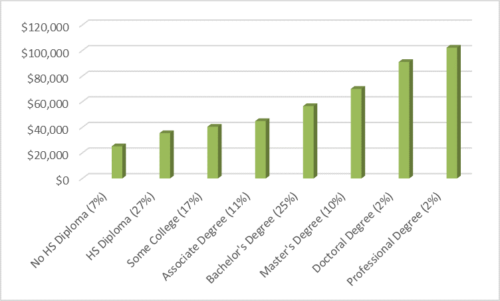The below essay is excerpted from Bush Helzberg’s excellent book, Charter Schools Work: America’s Failing Urban School Districts Can Be Transformed.
Politicians talk about a grand bargain in America. If you work hard, you can have a comfortable middle class job or better. Any career is possible regardless of one’s ethnicity or socioeconomic status at birth.
Unfortunately, the reality in America today is not even close to this ideal. A staggering disparity exists between college completion rates for students from wealthy and low-income families in the United States. According to a 2015 article in the Wall Street Journal, nationally only 9% of students from lowest quartile income families earn a college degree by the time they turn 24. However, 77% of students from highest quartile income families earn a college degree by the time they turn 24.[1]
College Completion Gap

In the 21st century a college education is critical. A report from the McCourt School of Public Policy at Georgetown forecasts that by 2018, 63% of all jobs will require at least some postsecondary education. The vast majority of jobs that pay enough to allow a middle-class lifestyle or better require a college degree. As the chart below illustrates, individuals with a college degree earn significantly more than those with a high school degree or less.
Median Earnings of Full-Time Workers by Education Level[2]

The traditional public school systems in most of America’s urban cores have failed students for decades. Millions of students from low-income families have not had access to high-quality K-12 education. The result for many is a lack of available opportunities. There is no mystery as to why our inner cities are plagued by high unemployment, crime, and violence. If people are not educated, they do not have good opportunities. If they do not have good opportunities, they are much more likely to get involved in criminal activities and end up in the criminal justice system.
Education is a huge and important civil rights issue. African-Americans are much more likely to live in a zip code that has failing public schools and thus have been disproportionately impacted by the failure of our nation’s urban public school systems. The state of K-12 education in America’s inner cities is not only a tremendous social injustice, but is in direct conflict with the American Dream ethos inspired by the Constitution. To have a fair shot at the American Dream, all children must have the opportunity to have the preparation and skills to succeed in college.
One’s destiny in America should not be largely determined by one’s zip code and it does not need to be. In Kansas City where I grew up, the traditional public school district has been failing children for decades. Fortunately, in 1998, Missouri passed a charter school law which allowed others to operate public schools within the boundaries of the Kansas City Missouri School District (“KCMSD”). Charter public schools have collectively transformed the educational opportunities available for thousands of students in the KCMSD.
In 2016 charter public schools educated roughly 40% of the K-12 public school students living within the boundaries of the KCMSD. This level of market share is in the top five in the nation behind New Orleans, Detroit, and Washington, DC. Charter public schools have created a competitive educational landscape which has created an incentive for the traditional school district to improve. While the traditional Kansas City Missouri School District is still far from high-quality, it has shown meaningful improvement in recent years actually achieving its highest rating from the state in three decades for the 2015-2016 school year.
Charter public schools were created in the early 1990s to improve our nation’s public school systems. Charter schools are public schools and like traditional public schools, are funded by local, state and federal tax dollars based on student enrollment. They are free and do not have special entrance requirements. Charter schools are not religious and cannot discriminate against students on any basis. Just like traditional public schools, charter public schools are accountable for state and federal academic standards. As of 2016, there were more than 6,700 charter schools operating in 42 states and the District of Columbia educating nearly 3 million children.[3]
Today, K-12 education within the boundaries of the Kansas City Missouri School District is at an inflection point. There is even optimism among local education reform practitioners that a significant majority of the students in Kansas City, Missouri could be getting a high-quality education within a decade. Hopefully, this book will shed light on the progress that has taken place and potentially serve as a roadmap for others who have the desire and will to address failing inner-city school systems.
For the last decade as Chairman of University Academy (UA), a K-12 college-preparatory charter public school that serves 1,000 students who reside in the boundaries of the KCMSD, I have seen that it is possible for low-income students to achieve at the highest levels. I have also witnessed how multiple charter public schools can collectively create a competitive educational landscape that benefits students and the community.
[1] Melissa Korn, “Big Gap in College Graduation Rates for Rich and Poor, Study Finds,” Wall Street Journal, February 3, 2015.
[2] U.S. Census Bureau, 2012, Table PINC-03; Internal Revenue Service, 2010.
[3] From the website of the National Alliance for Public Charter Schools.

